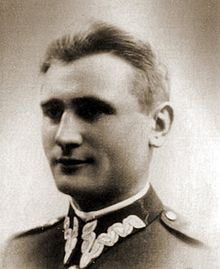At noon on the third day, the German commander, Heinz Guderian, threatened that all Polish POWs would be shot if the defense of the bunker did not cease.Turning to his men in the shelter, Raginis thanked them for the fact that they were soldiers and did their duty. He then ordered them to surrender and leave the shelter - he would keep his word and not surrender.
On September 7 Raginis' forces (approximately 720 men, out of which roughly 650 were killed) were attacked by more than 42,000 German soldiers.
To keep the morale of his men high, Raginis pledged that he would not leave his post alive.
Seweryn Biegański, who was the last to leave the shelter, describes the moment.
"The captain looked at me warmly and softly urged me to leave. When I was at the exit, I was hit on my back with strong gust and I heard an explosion."
Raginis then decided to end the resistance and committed suicide by throwing himself on a grenade.
In his diaries, Guderian noted that 900 German soldiers were killed in action, although that number is probably a low estimate. It is certain, however, that the Wehrmacht lost at least 10 tanks and several other AFVs in the struggle.
Destroyed TP-7 tank (Vickers) hit the front panel
The Germans agreed to allow burial of the corpses of Raginis and Lieutenant Stanisław Brykalski by Kazimierz Puchowicz, a friend of Raginis, next to the bunker where a tree was planted as an impromptu memorial. When the Red Army entered Wizna, the Soviet authorities ordered the bodies to be dug up and moved next to the Łomża - Białystok road, where an obelisk stands today.
His symbolic grave is located next to the ruins of the bunker in which he died.
---------------
 Władysław Raginis (June 27, 1908 – September 10, 1939) was a Polish military commander during the Polish Defensive War of 1939 of a small force holding the Polish fortified defense positions against a vastly larger invasion during the Battle of Wizna. Because the positions were held at great cost for three days before being annihilated with few survivors, Wizna is referred to as the Polish Thermopylae and Captain Raginis as a modern Leonidas.
Władysław Raginis (June 27, 1908 – September 10, 1939) was a Polish military commander during the Polish Defensive War of 1939 of a small force holding the Polish fortified defense positions against a vastly larger invasion during the Battle of Wizna. Because the positions were held at great cost for three days before being annihilated with few survivors, Wizna is referred to as the Polish Thermopylae and Captain Raginis as a modern Leonidas.Raginis was born in Dźwińsk (Daugavpils), Vitebsk Governorate, Russian Empire (present-day Latvia) to a landowning family with patriotic traditions. Soon after graduating from a gymnasium in 1927, he joined the Infantry NCO School in Komorowo near Ostrów Mazowiecka where he was a mediocre student and completed his studies in 1928. He then completed a short practice of the military and the same year he enrolled at the Infantry Officers School in Ostrów Mazowiecka.
One of his schoolmates recalled
"He had a borderland accent, and was quiet and shy. Slim, small, blond hair .... "
After graduating on July 15, 1930, he was assigned to the 76th Infantry Regiment stationed in Grodno, where he was a platoon commander and instructor-lecturer at the School Cadet Corps. In 1939, as a distinction, he was advanced to lieutenant and then to captain and assigned to the elite Border Defence Corps (KOP) as the commander of the 3rd company, heavy machine gun battalion, of the Border Defence Corps Regiment "Sarny" under the command of Lt-Colonel Nikodem Sulik.

In the late summer of 1939, the "Sarny" Regiment sent the bulk of its forces to Upper Silesia to man the Fortified Area Silesia, some units, including Raginis, instead went to Osowiec Fortress, near the border with East Prussia.
In anticipation of the outbreak of the Second World War, on September 2, 1939, Major Jakub Fober gave Raginis command of all the Wizna Fortified Area, a buffer of 9 kilometres (5.6 miles) between the Narew River and Biebrza River, which was part of defensive line of Independent Operational Group "Narew" on the right wing of Polish forces.
"Wizna" secured a major artery of communication, the Łomża – Białystok road and the Zambrów – Osowiec railway.
It is worth noting that some of the shelters were incomplete as war broke out, some had little to no ventilation, many of them not camouflaged and some were not fitted with armored observation domes. The incomplete state of the shelters significantly reduced the combat capability of the emplacements.






Beautiful polish myth. What he did not convince Poles of the Polish People's Republic was made by the Swedish band Sabaton.
VastaaPoistaHi.
PoistaFunny and interesting too
So, this should be a real myth? no nothing real story!
But still, Do you know :)
Sabaton also sings on the Winter War, and it's not a myth